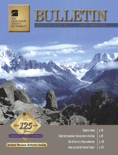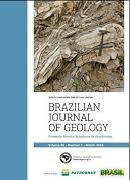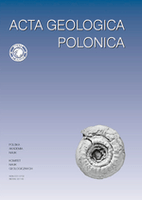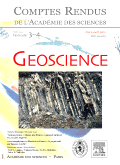
GEOLOGICAL SOCIETY OF AMERICA BULLETIN
Scope & Guideline
Leading the Charge in Earth Science Scholarship
Introduction
Aims and Scopes
- Tectonics and Structural Geology:
Research in this area includes studies on fault mechanics, tectonic evolution, and the structural characteristics of various geological formations, providing insights into the forces shaping the Earth's crust. - Geochronology and Radiometric Dating:
The journal publishes articles that utilize various dating methods, such as U-Pb zircon geochronology, to establish the age of geological formations and events, thereby contributing to the understanding of Earth's history. - Petrology and Geochemistry:
Papers in this scope focus on the origin, composition, and evolution of rocks, including igneous, sedimentary, and metamorphic processes, often employing advanced analytical techniques to elucidate mineral compositions. - Paleoenvironmental and Paleoclimatic Studies:
This includes research that reconstructs past environments and climate conditions through sedimentological, geochemical, and paleontological evidence, helping to understand long-term Earth system changes. - Volcanology and Igneous Processes:
The journal features studies on volcanic activity, magma formation, and related phenomena, exploring the dynamics of volcanic systems and their impact on the environment. - Sedimentology and Stratigraphy:
Research on sedimentary processes, basin evolution, and stratigraphic frameworks is central to the journal, providing insights into depositional environments and geological history. - Geohazards and Environmental Geology:
This area covers studies on natural hazards like earthquakes, landslides, and volcanic eruptions, as well as the geological factors influencing environmental issues.
Trending and Emerging
- Climate Change and Geosciences:
There is a growing emphasis on studies that examine the geological impacts of climate change, including sedimentary responses to climatic shifts, paleoclimatic reconstructions, and the interactions between geological processes and climate dynamics. - Geodynamics and Plate Tectonics:
Research focusing on the dynamics of tectonic plates, including subduction processes, continental collision, and their effects on geological features, has gained prominence, reflecting advancements in geophysical modeling and observational techniques. - Geochemical Cycling and Environmental Impact:
Emerging research addresses the geochemical processes related to environmental issues, such as pollution and resource extraction, highlighting the role of geology in understanding and mitigating environmental impacts. - Integrated Geoscience Approaches:
There is a trend towards interdisciplinary studies that combine geology with other scientific fields, such as biology, chemistry, and physics, to provide comprehensive insights into complex geological problems. - Natural Hazards and Risk Assessment:
Research on natural hazards, including earthquakes, landslides, and volcanic eruptions, has increased, focusing on risk assessment and mitigation strategies, reflecting the growing societal need for understanding geological hazards.
Declining or Waning
- Sedimentary Petrology:
Although sedimentology remains a core area, specific studies focused solely on sedimentary petrology have decreased, possibly due to a shift toward more integrated approaches that combine sedimentology with geochemistry and stratigraphy. - Paleoecology and Biostratigraphy:
Research specifically targeting paleoecological reconstructions and biostratigraphic correlations has seen a decline, as the field evolves towards interdisciplinary studies that incorporate broader geochemical and geophysical data. - Mineralogy:
While mineralogical studies are still relevant, the number of papers focusing exclusively on mineralogical characteristics without broader geological context has diminished, reflecting a trend towards integrating mineralogy with petrology and geochemistry. - Historical Geology:
Research focused on historical geology, particularly studies that do not incorporate modern analytical techniques or interdisciplinary approaches, appears to be waning, as the field moves towards more dynamic and integrative geological research.
Similar Journals

INTERNATIONAL JOURNAL OF EARTH SCIENCES
Connecting Global Insights in Earth SciencesINTERNATIONAL JOURNAL OF EARTH SCIENCES, published by Springer, is a leading journal in the field of Earth and Planetary Sciences, distinguished by its Q1 quartile ranking in the 2023 category of Earth and Planetary Sciences (miscellaneous). With an ISSN of 1437-3254 and an E-ISSN of 1437-3262, this journal has been a pivotal platform for researchers, academics, and practitioners since its inception in 1996. The journal's focus encompasses a broad range of topics within Earth sciences, making it a vital resource for contributions that enhance our understanding of geological processes, climate change, and planetary dynamics. The impact factor reflects its high standards and the significance of the research it publishes, ranking it in the 74th percentile among its peers as per Scopus. Furthermore, the journal offers Open Access options, facilitating the global dissemination of groundbreaking research. The editorial team is committed to advancing knowledge in Earth sciences, serving as an essential reference for students and professionals looking to engage deeply with this dynamic field.

GEOLOGICAL MAGAZINE
A Legacy of Excellence in Geological ScholarshipGEOLOGICAL MAGAZINE, published by Cambridge University Press, is a premier journal in the field of geology, renowned for its rich legacy since 1864 and ongoing contributions to Earth and Planetary Sciences. With an impressive Q1 ranking in Geology and a Scopus rank of #70 out of 321 journals, it holds a significant position within the academic community, appealing to researchers, professionals, and students alike. The journal covers a wide array of topics, ensuring a comprehensive platform for the dissemination of cutting-edge geological research. Although it does not offer open access, it remains a vital resource for those seeking to stay abreast of advancements in the field. With an enduring commitment to quality, GEOLOGICAL MAGAZINE stands as an essential outlet for scholarly communication and serves as a catalyst for academic discourse within the geological sciences.

Brazilian Journal of Geology
Empowering Global Geoscientific CollaborationBrazilian Journal of Geology, the flagship publication of the SOC BRASILEIRA GEOLOGIA, has been a beacon of geoscientific research since its inception in 2013. With an ISSN of 2317-4889 and an E-ISSN of 2317-4692, this open-access journal has facilitated the dissemination of high-quality research across various branches of geosciences, making it freely accessible to a global audience since 2014. Hailing from Brazil, the journal proudly holds a Q2 ranking in Earth and Planetary Sciences as of 2023, and ranks #73 out of 195 in Scopus, indicating its growing impact and relevance in the field. The Brazilian Journal of Geology aims to bridge diverse geological studies with interdisciplinary approaches, promoting the understanding and application of geology in addressing contemporary scientific challenges. As it converges research from 2013 to 2024, the journal not only enriches the academic landscape but also serves as a vital resource for researchers, professionals, and students eager to explore the complexities of the Earth and its processes.

Boletin de Geologia
Innovating Earth Science: Discover, Share, Collaborate.Boletin de Geologia is a prominent open-access journal published by UNIV INDUSTRIAL SANTANDER, dedicated to advancing the field of Earth and Planetary Sciences. Since its transition to open access in 2000, this journal has provided a platform for researchers to disseminate their findings and engage with the global scientific community. With an ISSN of 0120-0283 and an E-ISSN of 2145-8553, it is indexed in Scopus and has secured a notable Q3 ranking in the category of miscellaneous Earth and Planetary Sciences as of 2023, reflecting the impact and relevance of its published articles. The journal's geographical scope, rooted in Colombia, allows it to highlight significant geological research pertinent to the region while also contributing to global discussions. Scholars and practitioners interested in innovative research within this field will find Boletin de Geologia an invaluable resource for unlocking knowledge and fostering collaboration in the geological sciences.

GEOLOGICA ACTA
Exploring the depths of geology with global insights.GEOLOGICA ACTA is a distinguished open-access journal dedicated to the field of geology, published by Universitat de Barcelona since its inception in 2003. With an impact factor that reflects its relevance in the academic community and a commendable Q2 ranking within the Earth and Planetary Sciences category, this journal is committed to disseminating high-quality research that spans various aspects of geological sciences. The journal's broad scope encompasses both theoretical and applied research, making it a vital platform for researchers, professionals, and students alike to share their findings with a global audience. With its Open Access policy, GEOLOGICA ACTA ensures that all published articles are freely accessible, fostering collaboration and innovation in the geological community. Based in Barcelona, Spain, at the Geociences Barcelona (CSIC), it plays a pivotal role in connecting scholars from diverse backgrounds and advancing the field of geology through rigorous peer-reviewed articles.

Journal of Earth Science
Advancing knowledge in Earth and Planetary Sciences.Journal of Earth Science, published by the China University of Geosciences, Wuhan, is a leading journal in the field of Earth and Planetary Sciences, recognized for its significant contributions to the understanding of geological processes and environmental challenges. With an impressive Q1 ranking among Earth and Planetary Sciences journals and a strong position at Rank #39/195 in Scopus, this journal not only showcases high-quality research but also serves as a crucial platform for disseminating innovative findings, spanning a broad spectrum of topics from geophysics to climate change. The journal adopts an open access model, which enhances the visibility and accessibility of research articles published from 2009 to 2024, thereby facilitating collaboration and knowledge sharing among the global scientific community. With its commitment to advancing geosciences, Journal of Earth Science is invaluable for researchers, professionals, and students alike, eager to stay informed and contribute to ongoing discussions in this dynamic field.

Journal of Geosciences
Exploring the Depths of Geoscientific KnowledgeJournal of Geosciences is a distinguished peer-reviewed journal published by CESKA GEOLOGICKA SPOLECNOST, based in the Czech Republic, that serves as a vital platform for the dissemination of innovative research in the field of Earth and Planetary Sciences. With an ISSN of 1802-6222 and E-ISSN of 1803-1943, this journal has established its significance within the academic community, evidenced by its Q3 ranking in both Earth and Planetary Sciences and Geology. The journal covers a broad array of topics, making it an essential resource for researchers, professionals, and students interested in geoscientific advancements and discoveries. The Journal of Geosciences reflects a commitment to high-quality scholarship, embracing a variety of methodologies and interdisciplinary approaches, and provides open access to its content, thereby encouraging global collaboration and knowledge sharing among geoscientists. With a publication history converging from 2007 to 2024, it continues to be a prominent venue for critical conversations and developments in the ever-evolving field of geosciences.

GEOLOGICA CARPATHICA
Advancing Knowledge in Geology and BeyondGEOLOGICA CARPATHICA, with ISSN 1335-0552 and E-ISSN 1336-8052, is a distinguished open access journal published by the Slovak Academy of Sciences Geological Institute, serving as a pivotal platform for the dissemination of research in the field of Geology. Established in 1991 and continuing through 2024, the journal is recognized for its significant contributions to Earth and Planetary Sciences, evidenced by its 2023 Scopus ranking placing it in the second quartile (Q2) within Geology. With an H-index that showcases its impactful publications, GEOLOGICA CARPATHICA is committed to fostering scholarly communication while promoting accessible research, having adopted an open access model since 2009. Located in beautiful Bratislava, Slovakia, this journal aims to engage a global audience of researchers, professionals, and students interested in ecological, geological, and environmental studies, making it a prominent resource for enriching the scientific community's understanding of the Carpathian region and beyond.

ACTA GEOLOGICA POLONICA
Connecting researchers to the forefront of geological research.ACTA GEOLOGICA POLONICA is a distinguished journal published by the Polska Akademia Nauk, in collaboration with the University of Warsaw's Geology Department. Since its inception, it has served as a vital platform for disseminating innovative research in the field of Geology, reflecting a commitment to advancing scientific knowledge in Earth and planetary sciences. With an ISSN of 0001-5709 and an E-ISSN of 2300-1887, this journal provides a rigorous review process and is classified in the Q3 quartile for Geology as of 2023, indicating its growing influence in the discipline. Despite not being open access, the journal facilitates meaningful contributions that span a range of geological topics from fundamental research to applied sciences, thereby enriching the academic landscape. Researchers, professionals, and students alike are encouraged to engage with the valuable findings and discussions contained within its pages, which continue to shape the future of geological inquiry.

COMPTES RENDUS GEOSCIENCE
Bridging Disciplines in Geoscience Excellence.COMPTES RENDUS GEOSCIENCE, an esteemed open-access journal published by ACAD SCIENCES since 2020, serves as a vital platform for disseminating significant research in the field of Earth and Planetary Sciences. With an ISSN of 1631-0713 and E-ISSN of 1778-7025, this French journal is located at 23 Quai de Conti, Paris, 75006, France. Focusing on various sub-disciplines, it is recognized in the 2023 category quartiles as Q2 in Earth and Planetary Sciences (miscellaneous) and Q3 in Global and Planetary Change. The journal ranks #82 out of 195 in Earth and Planetary Sciences and #79 out of 120 in Environmental Science, reflecting its commitment to quality scholarship and impactful research. The journal's open-access model enhances accessibility, ensuring that researchers, professionals, and students alike can freely engage with cutting-edge findings that contribute to a deeper understanding of our planet and its systems. The ongoing convergence of knowledge from 2002 to 2024 positions COMPTES RENDUS GEOSCIENCE as a crucial resource in the evolving landscape of geosciences.